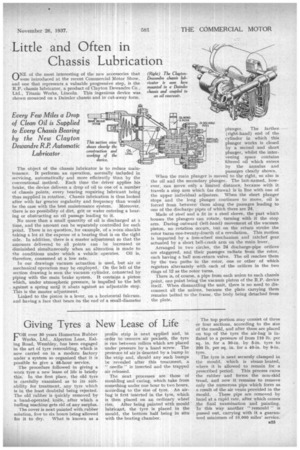Giving Tyres a New Lease of Life
Page 9

If you've noticed an error in this article please click here to report it so we can fix it.
FOR over 90 years Homerton Rubber Works, Ltd.. Alperton Lane, Ealing Road, Wembley, has been engaged in the art of tyre remoulding, which is now carried on in a modem factory under a system so organized that it is possible to give a 48-hour service.
The procedure followed in giving a worn tyre a new lease of life is briefly this. In the first place, the old tyre is carefully examined as to its suitability for treatment, any tyre which is in the least doubtful being rejected. The old rubber is quickly removed by a hand-operated knife, after which a buffing machine gets rid of any surplus.
The cover is next painted with, rubber solution, five to six hours being allowed for it to dry. What is known as a profile strip is next applied and, in order to remove air pockets, the tyre is run between rollers which are placed under pressure by a hand screw. The presence of air is denoted by a bump in the strip and, should any such bumps be revealed after this treatment, a " needle" is inserted and the trapped air released.
The next processes are those of moulding and curing, which take from something under one hour to two hours, according to the size of tyre. An airbag is first inserted in the tyre, which is then placed on an ordinary wheel rim. After being painted with mould lubricant, the tyre is placed in the mould, the bottom half being in situ with the heating chamber.
The top portion may consist of three or four sections, according to the size of the mould, and after these are placed on top of the tyre the air-bag is inflated to a pressure of from 110 lb. per sq. in. for a 30-in. by 5-in. tyre to 200 lb. per sq. in. for a 40-in. by 9-in. tyre.
Thetyre is next securely clamped in the mould, which is steam heated, where it is allowed to remain for a prescribed period. This process cures the rubber and forms the non-skid tread, and now it remains to remove only the numerous pips which form as a result of the air vents provided in the mould. These pips are removed by hand at a rapid rate, after which comes the final examination and painting. fir this way another " remould " is passed out, carrying with it a guaranteed minimum of 10,000 miles' service.






























